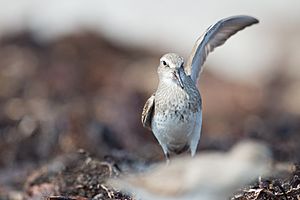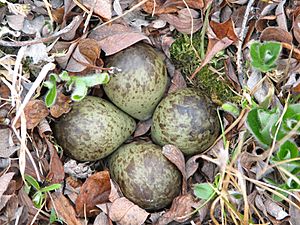White-rumped sandpiper facts for kids
Quick facts for kids White-rumped sandpiper |
|
|---|---|
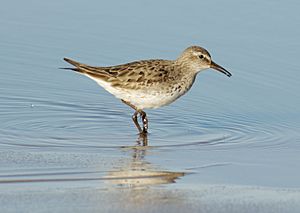 |
|
| Conservation status | |
| Scientific classification | |
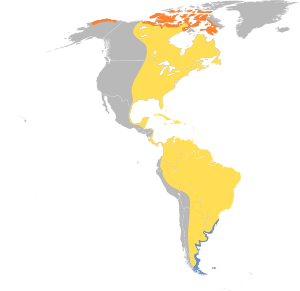 |
|
| Synonyms | |
|
Erolia fuscicollis |
The white-rumped sandpiper (Calidris fuscicollis) is a small shorebird. It breeds in the cold northern areas of Canada and Alaska. This bird can be tricky to tell apart from other tiny shorebirds. These small birds are often called "peeps" or "stints."
You don't often see these birds. In summer, they live in very remote breeding spots. In winter, they fly far south, making them hard for many people to spot. Most sightings happen in spring or fall. You usually see them in small groups near water.
Contents
About the White-Rumped Sandpiper
What Kind of Bird Is It?
The white-rumped sandpiper belongs to the class Aves, which includes all birds. As a shorebird, it is part of the order Charadriiformes. This group also includes gulls, alcids, plovers, and oystercatchers.
Its family, Scolopacidae, includes all sandpipers. It is grouped in the genus Calidris. This bird is a "monotypic species." This means there are no different types or subspecies of white-rumped sandpipers.
The name Calidris comes from an Ancient Greek word. It was used by Aristotle for some grey birds found near water. The name fuscicollis comes from Latin words. Fuscus means "dusky" (dark), and collis means "necked."
Appearance and Identification
How Big Is It?
The white-rumped sandpiper is a fairly small bird. It measures about 7.8 in (20 cm) long. Its upper body is a dull grey-brown color. It also has a white stripe above its eye.
Its beak is thin, dark, and medium-sized. Its legs are very dark. This bird is often confused with other similar sandpipers. These birds live in the same areas or along its migration path.
What Does Its Feathers Look Like?
The feathers look less bright in winter. However, males and females look similar all year round. In summer, the top of its head and face are brownish. It has a pale stripe above its eye. Its back feathers are black, and its wing feathers have grey edges. Its chest and sides have streaks, and its belly is white.
In winter, its upper body is dark grey with black centers on the feathers. Its belly is white, but its chest is dark grey. The stripe above its eye is white, while its head and eye-line are darker. Young birds have black feathers on their back and wings. These feathers have brown edges near the shoulders and white edges near the wingtips. Their chest has fine streaks. They have a white "V" shape on their back. Their belly and eye stripe are white, and their head is brownish.
| Standard Measurements | |
|---|---|
| Length | 170–200 mm (6.8–8 in) |
| Weight | 42 g (1.5 oz) |
| Wingspan | 430 mm (17 in) |
| Wing | 117–126 mm (4.6–5.0 in) |
| Tail | 47.5–53.6 mm (1.87–2.11 in) |
| Beak Length | 20–23.6 mm (0.79–0.93 in) |
| Leg Length | 21–24.5 mm (0.83–0.96 in) |
How to Identify It?
Two main things help you identify this bird. It has long wings and a white patch on its rump (its lower back). You can see the white patch when the bird is flying. Its long wings stick out past its tail by about a quarter inch.
Baird's sandpiper also has long wings. But you can tell it apart because it does not have a white rump. The white-rumped sandpiper also has a thin white stripe on its wing. It has a row of marks on its sides, below its wings.
Habitat and Migration
Where Do They Live?
The white-rumped sandpiper lives in grassy parts of the tundra. During the breeding season, they live in wet, heavily vegetated, bumpy arctic tundra in Alaska and Canada.
When they migrate, they can be found in different types of wetlands. These include lagoons, estuaries, and marshes. In winter, they use both freshwater and saltwater habitats. They usually avoid sandy beaches and fast-moving water.
Their Long Journey
These birds are long-distance migrants. They spend winter in southern South America and the Caribbean. They are known for traveling extremely long distances. They cross all of North America in just one month.
After breeding in northern Canada and Alaska, they fly over the Atlantic Ocean. They spend most of their non-breeding time in South America. They are often found along the Patagonian coast in Chile and Argentina. They also visit Fracasso Beach, Argentina, often. Many shorebirds gather here because there are lots of intertidal invertebrates, especially clams.
White-rumped sandpipers have also been seen in Venezuela, Suriname, Brazil, and Paraguay during their migration. They are rare visitors to western Europe and even rarer in Australia.
How They Travel
The birds migrate with both nonstop flights and shorter flights with multiple stops. When flying from north to south, they fly over the Atlantic Ocean. They slowly move along the northeastern coast of South America. Then they head inland towards the islands. This trip usually takes about one month.
When migrating from south to north, they follow a similar path. But they do it much faster. This migration is a series of long flights without stopping. One nonstop flight can be as long as 4,200 km (2,600 mi).
Weather plays a big role in their migration route. Birds like to travel when the temperature, pressure, and humidity help them with tailwinds. Strong winds can blow birds off their usual path. For example, a big storm once caused more white-rumped sandpipers to appear on the King George Islands.
How Climate Change Affects Them
Warmer weather has changed how many white-rumped sandpipers are seen. It also affects how long they stay in the South Shetland Islands. More of these birds are seen there now due to changes in climate. Higher air temperatures, caused by northern winds, bring warm, moist air. This creates more open habitats and better food sources for the birds. Their migration routes and feeding grounds might also change because of this.
Behavior and Life Cycle
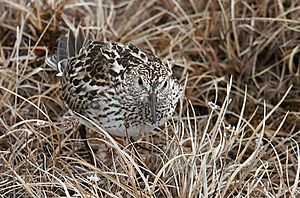
What Sounds Do They Make?
One sound the white-rumped sandpiper makes is a repeating "pip, pip, pip…" Their call has a special metallic "tzeep" sound. This makes them easy to spot in a group of shorebirds. It sounds like two small stones scraping together.
What Do They Eat?
Their diet is mostly small invertebrates. These include molluscs, crustaceans, annelids, and both adult and young insects. They mainly eat invertebrates found in water.
It was once thought they only ate invertebrates. But now we know that seeds are also part of their diet. This discovery suggests they might be opportunistic feeders. This means they eat whatever food is available, depending on the time, season, and where they are. Stones and algae have also been found in their stomachs. But these were likely eaten by accident. The stones are similar in shape and size to seeds, so they might be mistaken. Algae could also be eaten by accident while feeding in water.
When on mudflats, the white-rumped sandpiper searches for food by poking its beak into shallow water and mud. It can also pick up items from the surface. In the tundra, they have to poke deep into moss and other plants to find food.
Nesting and Reproduction
The female builds the nest. It's a cup-shaped dip in the ground. The nest is lined with pieces of lichen, leaves, and moss. These materials can be found naturally or added by the female. Nests are usually well hidden in a clump of moss or grass.
Males protect their breeding area. They glide and flutter above it, making "oinking" and "rattling" sounds. On the ground, the male stretches out a wing and raises its tail. This shows off the white patch on its rump. Then he walks and runs while repeating a call.
Like most shorebirds, the white-rumped sandpiper's courtship behavior involves flying. During courtship, the male and female fly upwards side by side. They stop about 10 m (33 ft) above the ground. They hover about 0.5 m (1.6 ft) apart, flapping their wings quickly. The male stays above the female and makes "poing-zee" sounds. They hover for 5 to 10 seconds. Then they slowly and quietly fly down to the ground. They land about 2 m (6.6 ft) apart. As they glide down, their wings are held in a "V" shape above their backs. A few minutes later, they do a second flight just like the first. After they land, the male chases the female. The chase ends when the male does a wing-raising display. This is common in many sandpiper species.
Female white-rumped sandpipers are small and nest in the far north. This means they might feel the cold more than birds in warmer areas. So, females spend about 82.5% of their time keeping their eggs warm. In total, females incubate the eggs for about 22 days. She usually lays 4 olive to green eggs. Laying 3 eggs is rare. The eggs can sometimes have brown, olive-brown, or grey spots.
Only the females incubate the eggs. Once the female lays the eggs, the male stops his displays and leaves the breeding area. This is different from other Calidris sandpipers. In those species, both parents share the egg incubation. White-rumped sandpiper males will mate with several females. But females will only mate with one male.
Sometimes, hybrids (mixed species) between this bird and the dunlin are found. This happens in northeastern North America.
Early Life
The young birds are covered in soft down feathers. They leave the nest about a day after hatching. The female will care for them by keeping them warm. However, the young birds must find all their own food. They take their first flight at about 16–17 days old. Soon after that, they become independent.
Images for kids
Calidris fuscicollis in Field Guide: Birds of the World on Flickr species name is missing
See also
 In Spanish: Correlimos culiblanco para niños
In Spanish: Correlimos culiblanco para niños



